Instruction
6 fundamental steps to building your mental game

A big problem I see with golfers is that most players understand the importance of the mental game to performance, but don’t know how to develop it. There’s a lot of work required to build the necessary mental skills, just like there’s a lot of work that goes into building a proper golf swing.
Similar to the physical game, there’s a lot of information out there about the mental/emotional game that offers short-term tips, tricks and shortcuts. While those ploys are seductive, they aren’t a long-term solution.
Instead, we need to build a strong mental foundation from which we can build upon. Building the right foundation and then shaping that based on our strengths, limitations and triggers is the way to create sustainable performance and a stable mental/emotional platform.
So how can you begin to work on your mental game each day so that you build it over time and it becomes a core strength? Below are keys to develop a long-lasting, stable mental approach to play your best golf.
The 6 fundamentals
Follow these steps to building a strong mental golf game:
- What’s your plan? Create a plan for exactly what you want and what you want to achieve in the game. What would you like to do and what might be the steps to accomplish it? So many players have no direction, no timelines and do not know what they want — so there is constant frustration and a feeling like they are on a treadmill, going nowhere. Have a plan and a long-term direction.
- Why do you play? It seems simple, but it is an important question to support your plan. The best, most authentic reasons for playing are because you love the game and enjoy the feeling you get from it. If these are your reasons, keep them fresh in your mind and be careful not to get caught up in all the negative little details that can distract you from these genuine purposes.
- Assess, assess, assess. Knowing where you are is important in taking the steps to improvement. We assess every athlete to understand where he or she might be mentally/emotionally and it provides a starting point in creating a development plan. Do you know exactly what you need mentally/emotionally so you can create your own plan? We use the Emotional Intelligence Sports Inventory (ESi) at newedgeperformance.org to help us get initial baseline readings from which we can build a game plan.
- Reflect. It’s very important to use the information you are creating in your game to always move forward. Take the lessons from each practice session and each round and evaluate what specific areas need work. The best players take at least one lesson from every practice session or round and apply it moving forward. Ask yourself what you learned from each of your sessions and rounds and how this information can be adapted moving forward.
- Create your own “emotional caddie.” Build your own positive support system — an environment within yourself that you can play in. The tendency for most players is to be negative and self-critical. Learn to build a conscience and voice that supports what you do and is your own best friend. Download my book, free to you, to learn more about building your emotional caddie. See johnhaime.com for download: Chapters 7 and 8.
- Always build confidence. Understand what confidence is, threats to your confidence, when you might have confidence and when you don’t, and create a plan to proactively build it. Fear is often the antithesis of confidence. What causes fear in your game and prevents you from having a positive, proactive, confident approach?
There are many skills required to having a solid, positive, authentic mental/emotional approach. Like the golf swing and the physical skills required to play the game, however, the fundamentals and foundation are the backbone of this part of your game, too. With a solid foundation and structure, you will still encounter the unavoidable low points, but you will have the skills to navigate these points and move out of them quickly.
- LIKE125
- LEGIT48
- WOW12
- LOL1
- IDHT2
- FLOP6
- OB4
- SHANK21
Instruction
The Wedge Guy: The easiest-to-learn golf basic

My golf learning began with this simple fact – if you don’t have a fundamentally sound hold on the golf club, it is practically impossible for your body to execute a fundamentally sound golf swing. I’m still a big believer that the golf swing is much easier to execute if you begin with the proper hold on the club.
As you might imagine, I come into contact with hundreds of golfers of all skill levels. And it is very rare to see a good player with a bad hold on the golf club. There are some exceptions, for sure, but they are very few and very far between, and they typically have beat so many balls with their poor grip that they’ve found a way to work around it.
The reality of biophysics is that the body moves only in certain ways – and the particulars of the way you hold the golf club can totally prevent a sound swing motion that allows the club to release properly through the impact zone. The wonderful thing is that anyone can learn how to put a fundamentally sound hold on the golf club, and you can practice it anywhere your hands are not otherwise engaged, like watching TV or just sitting and relaxing.
Whether you prefer an overlap, interlock or full-finger (not baseball!) grip on the club, the same fundamentals apply. Here are the major grip faults I see most often, in the order of the frequency:
Mis-aligned hands
By this I mean that the palms of the two hands are not parallel to each other. Too many golfers have a weak left hand and strong right, or vice versa. The easiest way to learn how to hold the club with your palms aligned properly is to grip a plain wooden ruler or yardstick. It forces the hands to align properly and shows you how that feels. If you grip and re-grip a yardstick several times, then grip a club, you’ll see that the learning curve is almost immediate.
The position of the grip in the upper/left hand
I also observe many golfers who have the butt of the grip too far into the heel pad of the upper hand (the left hand for right-handed players). It’s amazing how much easier it is to release the club through the ball if even 1/4-1/2″ of the butt is beyond the left heel pad. Try this yourself to see what I mean. Swing the club freely with just your left hand and notice the difference in its release from when you hold it at the end of the grip, versus gripping down even a half inch.
To help you really understand how this works, go to the range and hit shots with your five-iron gripped down a full inch to make the club the same length as your seven-iron. You will probably see an amazing shot shape difference, and likely not see as much distance loss as you would expect.
Too much lower (right) hand on the club
It seems like almost all golfers of 8-10 handicap or higher have the club too far into the palm of the lower hand, because that feels “good” if you are trying to control the path of the clubhead to the ball. But the golf swing is not an effort to hit at the ball – it is a swing of the club. The proper hold on the club has the grip underneath the pad at the base of the fingers. This will likely feel “weak” to you — like you cannot control the club like that. EXACTLY. You should not be trying to control the club with your lower/master hand.
Gripping too tightly
Nearly all golfers hold the club too tightly, which tenses up the forearms and prevents a proper release of the club through impact. In order for the club to move back and through properly, you must feel that the club is controlled by the last three fingers of the upper hand, and the middle two fingers of the lower hand. If you engage your thumbs and forefingers in “holding” the club, the result will almost always be a grip that is too tight. Try this for yourself. Hold the club in your upper hand only, and squeeze firmly with just the last three fingers, with the forefinger and thumb off the club entirely. You have good control, but your forearms are not tense. Then begin to squeeze down with your thumb and forefinger and observe the tensing of the entire forearm. This is the way we are made, so the key to preventing tenseness in the arms is to hold the club very lightly with the “pinchers” — the thumbs and forefingers.
So, those are what I believe are the four fundamentals of a good grip. Anyone can learn them in their home or office very quickly. There is no easier way to improve your ball striking consistency and add distance than giving more attention to the way you hold the golf club.
More from the Wedge Guy
- The Wedge Guy: Golf mastery begins with your wedge game
- The Wedge Guy: Why golf is 20 times harder than brain surgery
- The Wedge Guy: Musings on the golf ball rollback
- LIKE86
- LEGIT13
- WOW6
- LOL1
- IDHT0
- FLOP4
- OB1
- SHANK8
Instruction
Clement: Stop ripping off your swing with this drill!

Not the dreaded headcover under the armpit drill! As if your body is defective and can’t function by itself! Have you seen how incredible the human machine is with all the incredible feats of agility all kinds of athletes are accomplishing? You think your body is so defective (the good Lord is laughing his head off at you) that it needs a headcover tucked under the armpit so you can swing like T-Rex?
- LIKE0
- LEGIT2
- WOW2
- LOL0
- IDHT0
- FLOP0
- OB0
- SHANK2
Instruction
How a towel can fix your golf swing
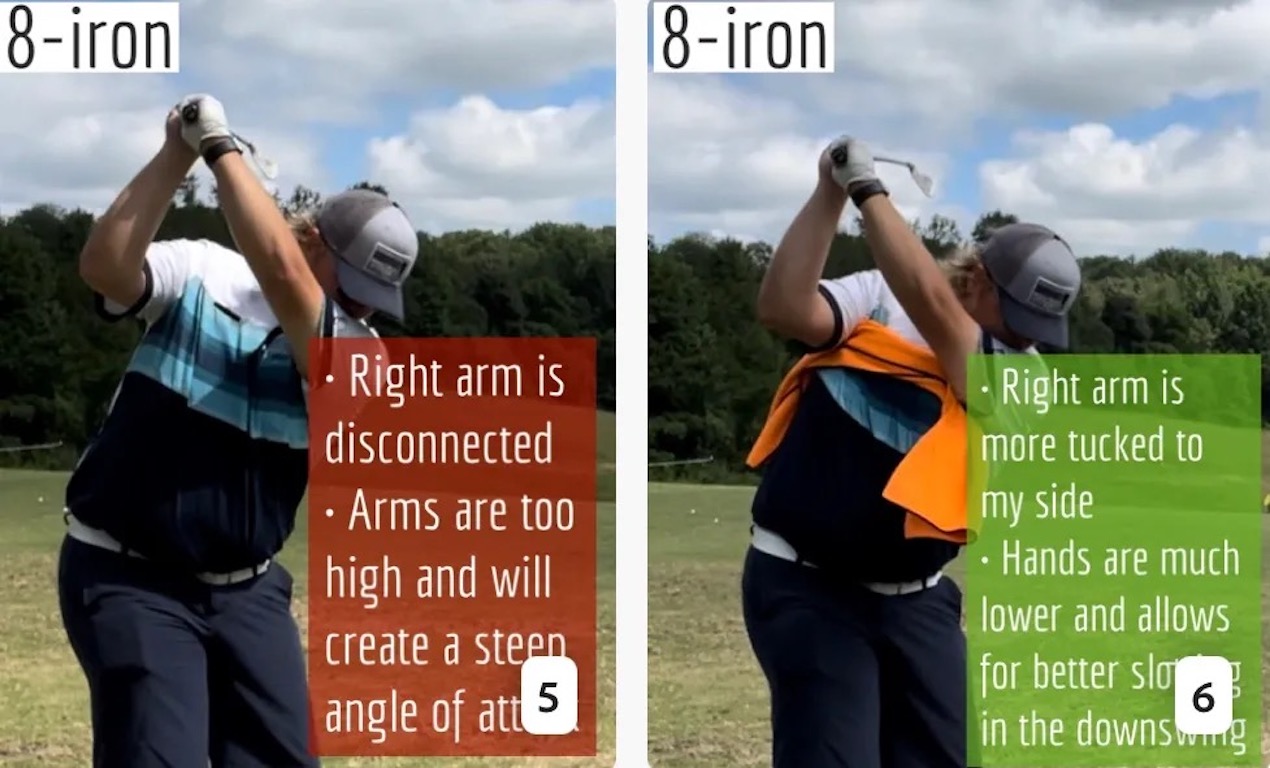
This is a classic drill that has been used for decades. However, the world of marketed training aids has grown so much during that time that this simple practice has been virtually forgotten. Because why teach people how to play golf using everyday items when you can create and sell a product that reinforces the same thing? Nevertheless, I am here to give you helpful advice without running to the nearest Edwin Watts or adding something to your Amazon cart.
For the “scoring clubs,” having a solid connection between the arms and body during the swing, especially through impact, is paramount to creating long-lasting consistency. And keeping that connection throughout the swing helps rotate the shoulders more to generate more power to help you hit it farther. So, how does this drill work, and what will your game benefit from it? Well, let’s get into it.
Setup
You can use this for basic chip shots up to complete swings. I use this with every club in my bag, up to a 9 or 8-iron. It’s natural to create incrementally more separation between the arms and body as you progress up the set. So doing this with a high iron or a wood is not recommended.
While you set up to hit a ball, simply tuck the towel underneath both armpits. The length of the towel will determine how tight it will be across your chest but don’t make it so loose that it gets in the way of your vision. After both sides are tucked, make some focused swings, keeping both arms firmly connected to the body during the backswing and follow through. (Note: It’s normal to lose connection on your lead arm during your finishing pose.) When you’re ready, put a ball in the way of those swings and get to work.
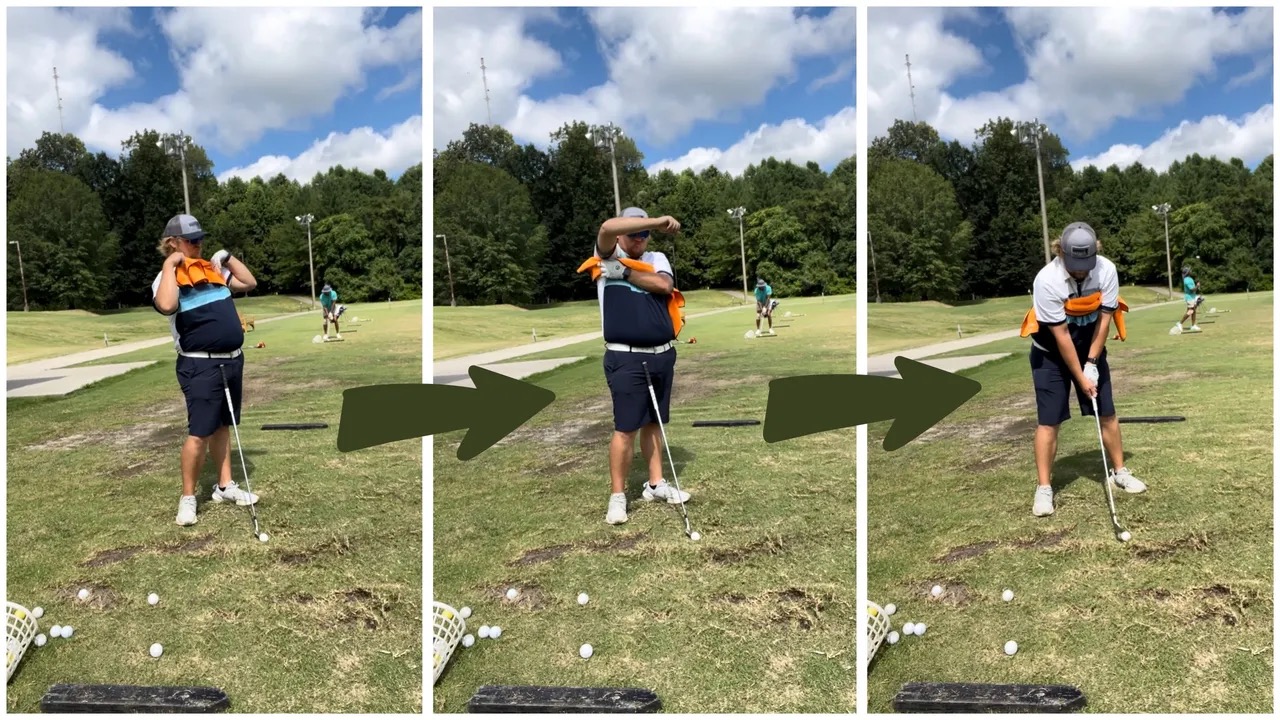
Get a Better Shoulder Turn
Many of us struggle to have proper shoulder rotation in our golf swing, especially during long layoffs. Making a swing that is all arms and no shoulders is a surefire way to have less control with wedges and less distance with full swings. Notice how I can get in a similar-looking position in both 60° wedge photos. However, one is weak and uncontrollable, while the other is strong and connected. One allows me to use my larger muscles to create my swing, and one doesn’t. The follow-through is another critical point where having a good connection, as well as solid shoulder rotation, is a must. This drill is great for those who tend to have a “chicken wing” form in their lead arm, which happens when it becomes separated from the body through impact.
In full swings, getting your shoulders to rotate in your golf swing is a great way to reinforce proper weight distribution. If your swing is all arms, it’s much harder to get your weight to naturally shift to the inside part of your trail foot in the backswing. Sure, you could make the mistake of “sliding” to get weight on your back foot, but that doesn’t fix the issue. You must turn into your trial leg to generate power. Additionally, look at the difference in separation between my hands and my head in the 8-iron examples. The green picture has more separation and has my hands lower. This will help me lessen my angle of attack and make it easier to hit the inside part of the golf ball, rather than the over-the-top move that the other picture produces.
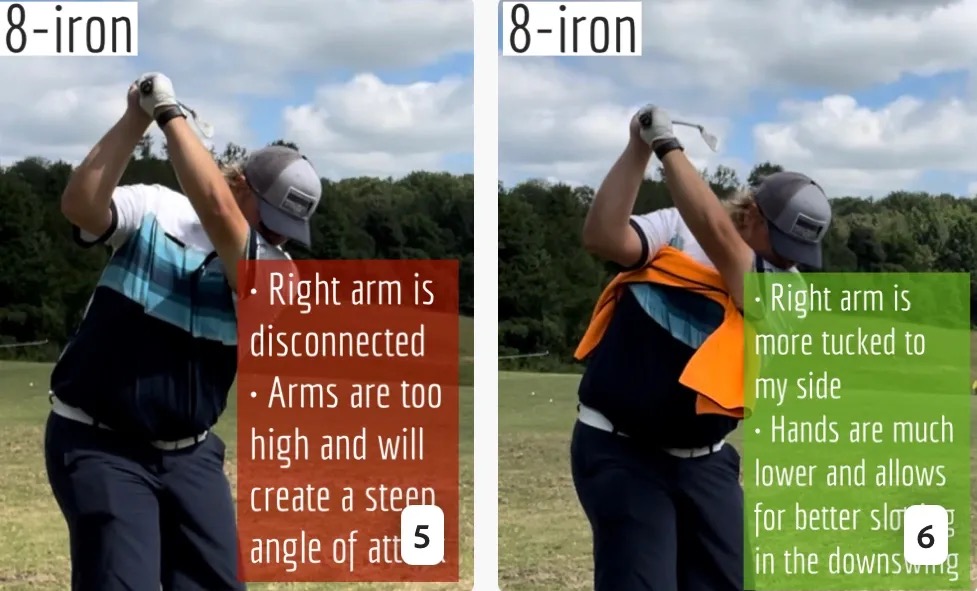
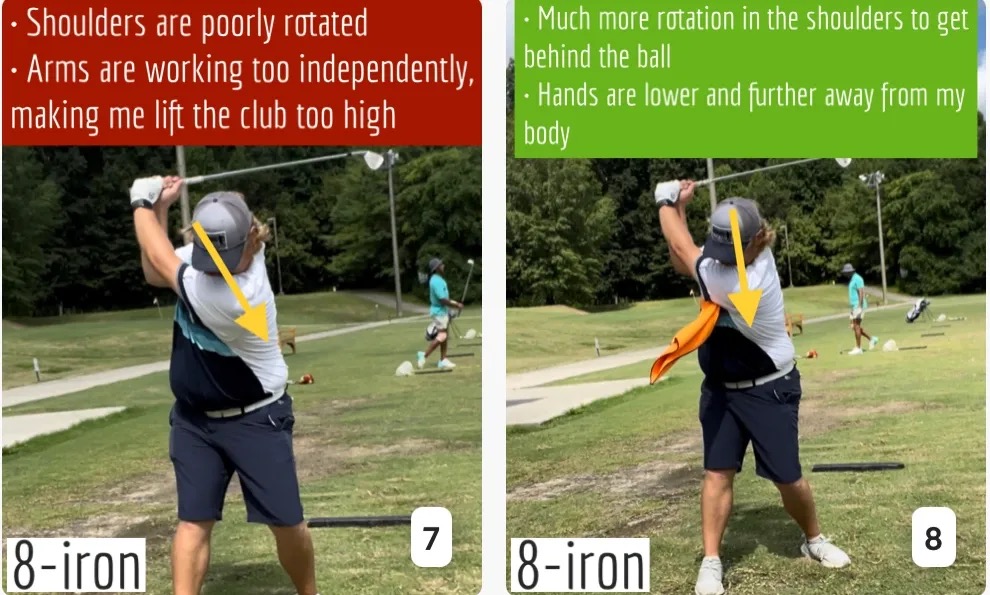
Stay Better Connected in the Backswing
When you don’t keep everything in your upper body working as one, getting to a good spot at the top of your swing is very hard to do. It would take impeccable timing along with great hand-eye coordination to hit quality shots with any sort of regularity if the arms are working separately from the body.
Notice in the red pictures of both my 60-degree wedge and 8-iron how high my hands are and the fact you can clearly see my shoulder through the gap in my arms. That has happened because the right arm, just above my elbow, has become totally disconnected from my body. That separation causes me to lift my hands as well as lose some of the extension in my left arm. This has been corrected in the green pictures by using this drill to reinforce that connection. It will also make you focus on keeping the lead arm close to your body as well. Because the moment either one loses that relationship, the towel falls.
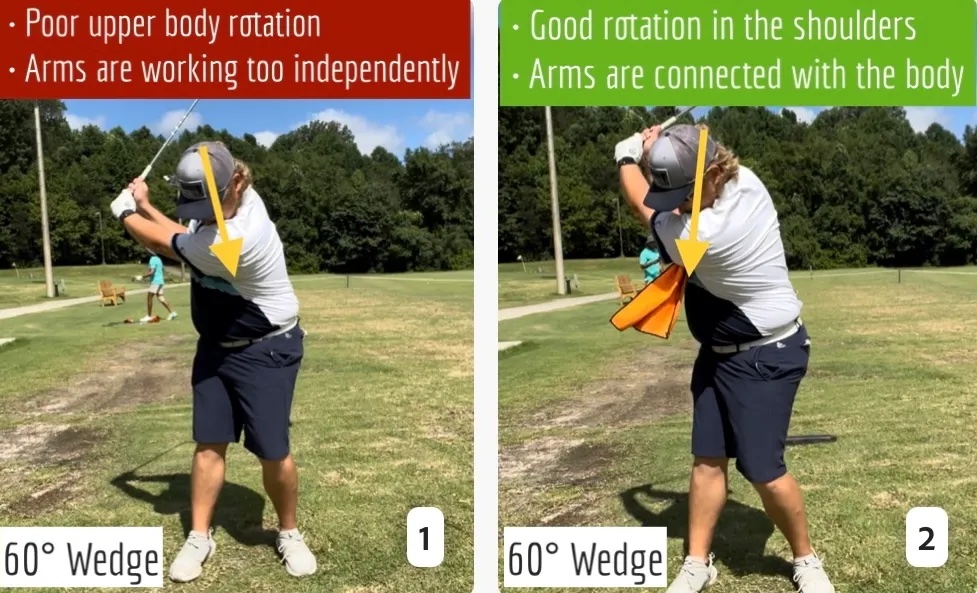
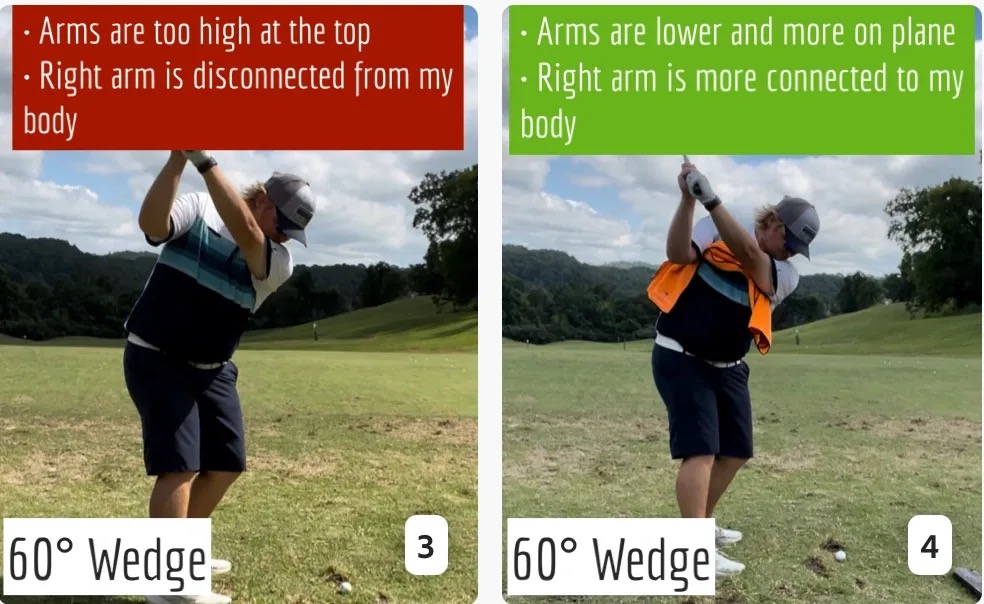
Conclusion
I have been diligent this year in finding a few drills that target some of the issues that plague my golf game; either by simply forgetting fundamental things or by coming to terms with the faults that have bitten me my whole career. I have found that having a few drills to fall back on to reinforce certain feelings helps me find my game a little easier, and the “towel drill” is most definitely one of them.
- LIKE12
- LEGIT2
- WOW2
- LOL0
- IDHT0
- FLOP2
- OB0
- SHANK8
-

 19th Hole2 weeks ago
19th Hole2 weeks agoDave Portnoy places monstrous outright bet for the 2024 Masters
-

 19th Hole2 weeks ago
19th Hole2 weeks agoTiger Woods arrives at 2024 Masters equipped with a putter that may surprise you
-

 19th Hole1 day ago
19th Hole1 day ago‘Absolutely crazy’ – Major champ lays into Patrick Cantlay over his decision on final hole of RBC Heritage
-

 19th Hole3 weeks ago
19th Hole3 weeks agoReport: Tiger Woods has ‘eliminated sex’ in preparation for the 2024 Masters
-

 19th Hole1 week ago
19th Hole1 week agoTwo star names reportedly blanked Jon Rahm all week at the Masters
-

 19th Hole1 week ago
19th Hole1 week agoReport: LIV Golf identifies latest star name they hope to sign to breakaway tour
-

 19th Hole1 week ago
19th Hole1 week agoNeal Shipley presser ends in awkward fashion after reporter claims Tiger handed him note on 8th fairway
-

 19th Hole6 days ago
19th Hole6 days agoBrandel Chamblee has ‘no doubt’ who started the McIlroy/LIV rumor and why
















Pingback: 6 fundamental steps to building your mental game - Dan Hansen Golf Instruction
John Haime
Oct 20, 2015 at 4:19 pm
Thanks Dan.
The very best to you!
John
Ale
Oct 15, 2015 at 6:56 am
Hi john I just read your 6 steps and the comments. I am not sure why you need professional credentials as stated in one of the comments . I agree that practical experience is what helps .
My grandson is a junior golfer and at times can’t move forward from a bad shot . Advice from his swing coach that we have had for 3 years helps him and he does not have a degree in psychology. Playing the game as a pro you find out what you need to move on from a bad shot.
Thanks for the advice.
John Haime
Oct 15, 2015 at 8:59 am
Thanks Ale – agreed.
I have found that performance goes far beyond the reaches of sport psychology – sports psyche is a small part of the puzzle. Professional credentials is a good starting point – and a step in the right direction – but applying learning in a very fast paced environment is very different – where results are demanded. Actively listenting, understanding people and what they need is also a skill that can’t really be taught. It really is about lifelong learning, learning from each situation and creating a process that can work in reality – and adapting that process to each athlete or team.
Many of the best people in performance in sports, who generated consistent results, have been the great coaches. John Wooden might be the best example. He created a culture and environment for athletes to play in – and was able to give them what they needed to excel. John grew up on a farm in Indiana, attended Purdue, had great coaching influences (Piggy Lambert at Purdue) and created a new approach at UCLA when he arrived. UCLA was 3-9 in conference when he arrived, had a few average seasons and then won 10 national championships in 12 years.
Thanks very much for the comment and story. The best to your grandson in his development as a golfer.
marcel
Oct 14, 2015 at 10:18 pm
there is a way to this. just go to your GP, tell its your marital issues, get the mental referral and then see shrink. with the shirk focus on mental strength related to golf.
sally
Oct 14, 2015 at 10:54 am
Do you incorporate any mindfulness practices into your teachings?
John Haime
Oct 14, 2015 at 11:00 am
Hi Sally,
Yes, with some performers very effective. Supports our work in self-awareness with the athletes. As you know, being able to focus in the moment is key in high performance. A focus on the past and future can be a major distraction and roadblock for performers depending on the degree.
Thanks for the comment!!
Thom G.
Oct 14, 2015 at 7:01 am
Being a retired Special Operations soldier of over 23 years, I’ve realized that E.I. played/plays a big part on how operators achieve success on missions. Through constant rehearsals, training and a fast paced operational tempo, gun slingers develop techniques to enable them to handle stress, make split second decisions and become highly proficient at their jobs during situations where most “normal” humans would freeze. Thanks for your insightful article.
John Haime
Oct 14, 2015 at 9:31 am
Great to have someone with practical experience make a great comment. You’ve been in the field under fire – so understand the value of controlling emotion and keeping things in perspective under pressure.
Golfer and all athletes have nowhere near this kind of pressure as sports is not life and death. But, the principles of recognizing emotions and managing them under pressure apply.
Thank-you so much for your service. Thanks also for thoughts and pleased you appreciate the article.
CD
Oct 14, 2015 at 3:53 am
I think it’s a good topic area and you have the experience to talk about it. I didn’t like the plug for your own product because it sounds like an independent company ‘we use…’ implying that you’ve looked at other companies products and it’s clearly your company. That’s (extremely) disingenuous (at best). I’m not sure how much $99 is as I don’t live in the states. It sounds expensive for something that is pretty intangible and esoteric.
I think the principles you espouse are very sound but they seem heavy on goal-setting and assessment and less on the content. What about practical steps for building confidence in a variety of golf specific contexts? What about effective suggestions for practice and development that marry technical and mental processes?
What about context? I also think they play upon the desire in us to get better. Which is fine, and a positive attitude and optimism is obviously beneficial. But I think reference surely has to be made to time available and where golf ranks amongst life’s priorities. The tendency is for people to get carried away (especially if they love the game and if they’re in wrx they probably do) with an unrealistic assessment of their ability within the context of everything else in their lives.
John Haime
Oct 14, 2015 at 10:54 am
Hey CD,
I think you’ll find some good info in the other articles I have written for WRX – confidence being one. They should give you some good ideas.
Please note that assessment and goalsetting are critical to performance. They give people starting points (and end points) and a path forward. How do you know what to work on if you don’t assess it? How do you know where you are going if you don’t have a plan and steps to get there? This is the weak point of many athletes. They work and work and have no direction – and wasted alot of time going in circles. The focus of this article is on foundation and fundamentals not specific details. Please follow the articles in the coming months for more.
FYI – I have given you a good article, my best-selling book and directed you to a world-class assessment that we have vetted as one of the best in the industry. Please note there are significant costs to a GOOD assessment. There are some that are online for free – but there is no science and validation behind them. The ESi is validated, has some great science behind it. It is also in a great format for you. It’s certainly a first for me to be called extremely disingenuous. I am only trying to help – and please realize we also have costs and it takes time and energy to produce great content for you – that you consume for free.
Stay tuned for more. Thanks again for your giving your opinion.
CD
Oct 14, 2015 at 4:15 pm
What you say is fine, I’m grateful for your polite response too. I’m not trying to get things for free, no problem at all paying a fair price. I’m also sure your product is excellent and this article has already been very informative and a reminder too – thank you, genuinely. I just think if you say ‘we use’ and then point to your *own* product, that is very disingenuous; it clearly implies some impartiality which isn’t there and it probably detracts from how good (I’m sure) it in fact is. Just be straight.
anon
Oct 13, 2015 at 7:42 pm
Rekt
shimmy
Oct 13, 2015 at 12:25 pm
You should re-write your blurb to say that you’re “one of the world’s leading authorities in the (disputed notion of) Emotional Intelligence”.
John Haime
Oct 13, 2015 at 1:11 pm
Thanks for the comment. Would be great to have your name and background to determine if your comment is worth taking seriously.
Everything can be disputed. Nothing in life is perfect or absolute. The only thing in performance that matters is results. We have the client list and track record to highlight that our interpretation of the principles around “Emotional Intelligence” work and move our performers to higher levels. There is nothing to dispute re: “being smart about emotions”. If you are a performer you know that emotions run the show in performance – so having knowledge and education around them might be a smart thing to do.
Many of the world’s top business leaders and thinkers integrate “Emotional Intelligence” into their cultures and understand the value in leadership. See http://www.billgeorge.org – one of the world’s leading experts on leadership. “Emotional Intelligence” is woven through everything he does and he actively pronounces the importance. Bill is at Harvard, a former successful CEO at Medtronic and comments on leadership on the networks.
Happy to take this offline if you would like more information and resources.
The best to you.
shimmy
Oct 14, 2015 at 11:12 am
Let’s just say that I’m around psychologists every day and I respect their expertise. It’s a little difficult to trust someone who calls himself one of the “world’s leading authorities” in a (controversial) subject when, as far as I can tell, he lacks academic credentials and seems to be here to sell his wares.
I am a performer for a living – not in golf – and I do recognize the importance of a deep understanding of one’s self and how that interacts with success “on stage”. I would just prefer people seek the help of a properly trained psychologist instead of an “interpreter” of psychological concepts.
John Haime
Oct 14, 2015 at 11:37 am
Thanks for the comment Shimmy – probably better to take this offline as mentioned. The social sciences is a long conversation.
Please note that working with athletes and performers is not clinical psychology but coaching. I hire Sports Psychologists on a regular basis and very few have been able to get the results the athletes are looking for. And, as I mention – it’s about results and nothing else. Paper on the wall is great – it gets your foot in the door – but it’s not the real world of results. A pro athlete in his contract year could not care less about educational credentials – they want results and if you don’t produce them – you don’t last.
See Thom’s comment above. Great comment that has value as he is in the field under fire under the most extreme conditions. Certainly gives EI some practical credibility.
Thanks again for your opinion.
BW
Oct 15, 2015 at 7:58 pm
you get what you pay for, bro.